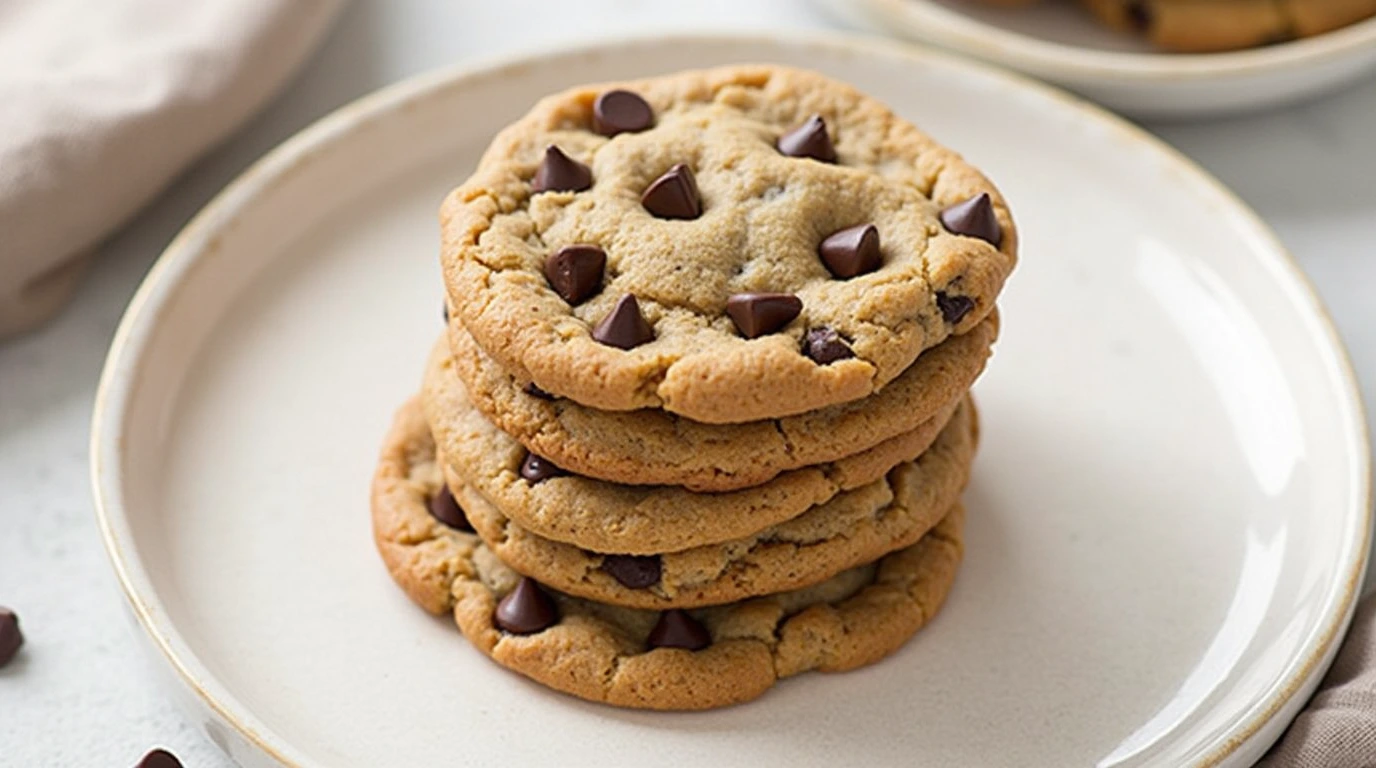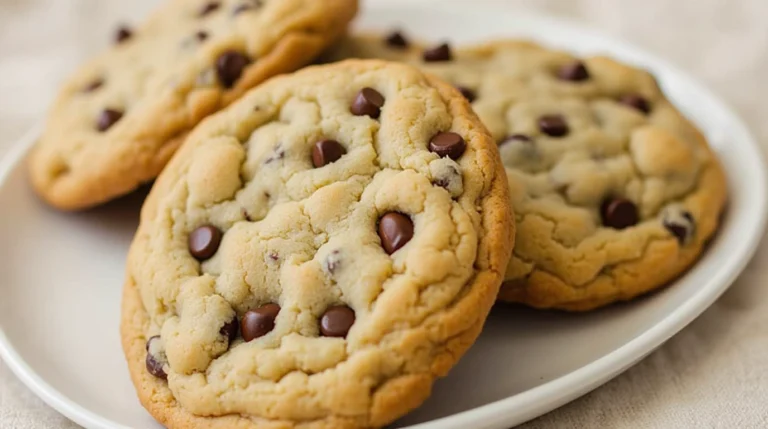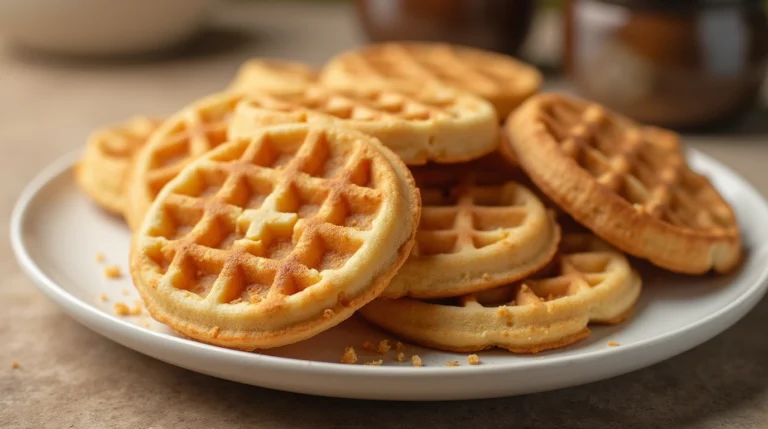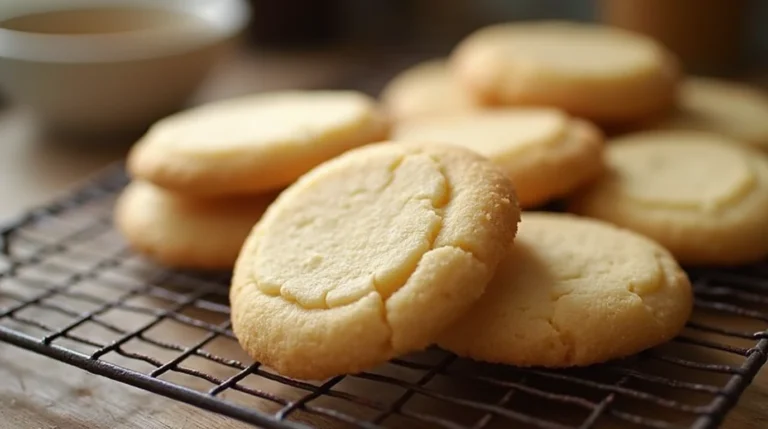The Best Vegan Chocolate Chip Cookies
Creating soft, chewy, and easy vegan chocolate chip cookies is a delightful endeavor that combines tradition with modern dietary choices. Chocolate chip cookies, a beloved treat since their invention in the 1930s by Ruth Graves Wakefield of the Toll House Inn in Whitman, Massachusetts, have evolved over time to accommodate various preferences and needs. Wakefield’s original recipe, which incorporated chopped Nestlé semi-sweet chocolate bars, laid the foundation for what would become an iconic dessert in American cuisine.
Table of Contents
Introduction
In recent decades, the rise of veganism and increased awareness of dietary restrictions have spurred bakers to reinvent classic recipes like the chocolate chip cookie. Vegan baking not only offers alternatives for those avoiding animal products but also introduces health benefits such as lower cholesterol levels and reduced saturated fat intake. Moreover, with recent challenges like egg shortages leading to higher prices, exploring egg-free baking options has become both a practical and ethical choice for many.
By embracing plant-based substitutes and innovative baking techniques, it’s possible to recreate the rich, comforting taste and texture of traditional chocolate chip cookies. This guide will explore the essential ingredients, provide a step-by-step baking process, and share expert tips to help you craft vegan chocolate chip cookies that are every bit as indulgent as their classic counterparts.
Essential Ingredients for Vegan Chocolate Chip Cookies
Achieving the ideal texture and flavor in vegan chocolate chip cookies hinges on understanding the role of each ingredient and making informed choices.
Flour
- All-Purpose Flour: This standard flour provides the classic cookie structure, balancing tenderness and chewiness.
- Gluten-Free Alternatives: For those with gluten sensitivities, a 1:1 gluten-free baking flour can be used. Brands like Bob’s Red Mill and King Arthur offer blends that yield excellent results.
Sweeteners
- Brown Sugar: Utilizing a higher ratio of brown sugar contributes to moistness and a rich, caramel-like flavor. For instance, a 2:1 ratio of dark brown sugar to cane sugar delivers soft centers, chewiness throughout, and nicely crisped edges.
- Granulated Sugar: Incorporating granulated sugar helps achieve the desired spread and contributes to a balanced sweetness.
Fats
- Vegan Butter: Mimics the richness of dairy butter and is crucial for flavor and texture. Brands like Earth Balance and Miyoko’s Creamery are popular choices.
- Coconut Oil: Provides a subtle coconut flavor and can be used as an alternative fat source. Ensure it’s in a solid but scoopable state for proper creaming.
Binders and Leavening Agents
- Flaxseed Meal: A common egg substitute, flaxseed meal adds a nutty flavor and helps bind the ingredients. To make a flax egg, combine one tablespoon of flaxseed meal with three tablespoons of water and let it sit for a few minutes to thicken.
- Applesauce: Acts as a moisture-rich binder, imparting a subtle sweetness. It’s particularly effective in creating a chewy texture.
- Baking Soda and Baking Powder: These leavening agents ensure the cookies rise properly, contributing to a light and tender crumb.
Flavor Enhancers
- Vanilla Extract: Adds depth and warmth to the cookie’s flavor profile.
- Salt: Balances the sweetness and enhances the overall taste.
Chocolate Components
- Vegan Chocolate Chips or Chopped Dark Chocolate: Ensure the chocolate is dairy-free. Brands like Enjoy Life offer vegan chocolate chips that melt beautifully and provide rich chocolatey pockets throughout the cookie.
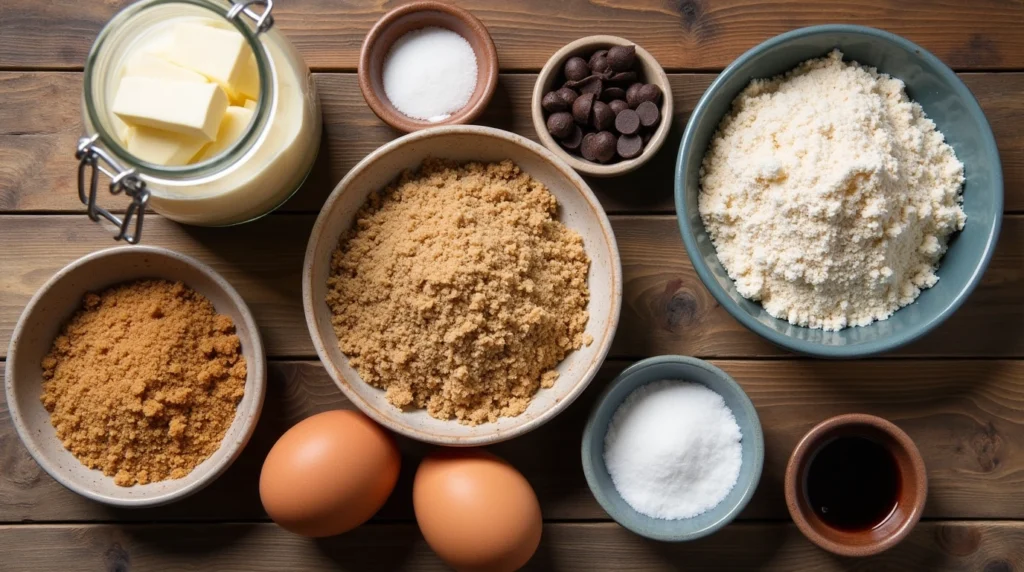
Step-by-Step Guide to Making Soft, Chewy, and Easy Vegan Chocolate Chip Cookies
A meticulous approach to each step ensures your vegan chocolate chip cookies achieve the desired texture and flavor.
Preparation
- Preheat the Oven: Set your oven to 350°F (180°C) to ensure it’s adequately heated by the time the dough is ready.
- Prepare Baking Sheets: Line your baking sheets with parchment paper or silicone mats to prevent sticking and promote even baking.
Combining Wet Ingredients
- Cream Vegan Butter and Sugars: In a large bowl, using a mixer or by hand, beat the softened vegan butter with brown and granulated sugars until the mixture is light and fluffy. This process incorporates air, contributing to the cookie’s structure.
- Incorporate Egg Substitute: Add your chosen egg substitute—such as a flax egg or applesauce—to the butter-sugar mixture. Mix until well combined, ensuring the binder is evenly distributed.
- Add Vanilla Extract: Stir in the vanilla extract to enhance the flavor profile.
Integrating Dry Ingredients
- Whisk Together Dry Components: In a separate bowl, combine the all-purpose flour, baking soda, and salt. Whisking ensures these ingredients are evenly distributed, preventing pockets of leavening agents.
- Combine Mixtures: Gradually add the dry ingredients to the wet mixture, mixing gently until just combined. Overmixing can develop gluten, resulting in tougher cookies.
Adding Chocolate
- Fold in Chocolate: Gently incorporate the vegan chocolate chips or chopped chocolate into the dough, ensuring even distribution without overmixing.
Shaping and Baking
- Portion Dough: Using a cookie scoop or tablespoon, place mounds of dough onto the prepared baking sheets, spacing them about 2 inches apart to allow for spreading.
- Bake: Place the baking sheets in the preheated oven and bake for 10-12 minutes, or until the edges are lightly golden. The centers may appear slightly undercooked but will firm up as they cool.
Cooling
- Initial Cooling: Allow the cookies to cool on the baking sheet for approximately 5 minutes. This helps them set and makes them easier to transfer.
- Transfer: Move the cookies to a wire rack to cool completely, ensuring they maintain their texture and prevent sogginess.
Tips and Tricks for Perfect Vegan Chocolate Chip Cookies
Implementing these expert tips can elevate your vegan chocolate chip cookies from good to exceptional.
Achieving Desired Texture
- Chewier Cookies: Slightly underbake the cookies, removing them from the oven when the centers are still soft. They will continue to set as they cool, resulting in a chewy texture.
- Crispier Edges: For cookies with crisp edges, bake them a bit longer until the edges are more golden. Ensure you monitor them closely to prevent overbaking.
Flavor Enhancements
- Sprinkle Sea Salt: Adding a light sprinkle of flaky sea salt on top of the cookies before baking enhances the sweet-salty contrast, elevating the overall flavor.
- Use High-Quality Vanilla Extract: Investing in
Conclusion
In conclusion, baking vegan chocolate chip cookies that are soft, chewy, and easy is not only achievable but also offers a rewarding experience that aligns with contemporary dietary preferences and sustainability goals. By embracing plant-based ingredients and innovative baking techniques, you can recreate the rich, comforting taste and texture of traditional chocolate chip cookies without compromising on flavor or ethics.
The history of the chocolate chip cookie, dating back to 1938 when Ruth Graves Wakefield invented it at the Toll House Inn, serves as a testament to the enduring appeal of this treat. Her creation has inspired countless variations, including those that cater to vegan diets, reflecting the evolution of culinary practices over time.
By experimenting with different plant-based substitutes and baking methods, you can craft cookies that not only satisfy your sweet tooth but also contribute to a more inclusive and sustainable culinary landscape. These vegan chocolate chip cookies demonstrate that with thoughtful ingredient choices and techniques, it’s possible to enjoy classic desserts in a modern, ethical, and health-conscious manner.
As you embark on your baking journey, remember that the heart of this endeavor lies in the joy of creation and the satisfaction of sharing delicious treats with others. Happy baking!
Frequently Asked Questions (FAQ)
1. What makes vegan chocolate chip cookies different from traditional ones?
Vegan chocolate chip cookies are made without animal-derived ingredients such as butter and eggs. Instead, plant-based substitutes like vegan butter and flaxseed meal are used to achieve similar textures and flavors. These cookies can be just as delicious and satisfying as their traditional counterparts.
2. How do I make a flaxseed egg, and why is it used?
A flaxseed egg is a common vegan substitute for chicken eggs in baking. To make one, mix 1 tablespoon of ground flaxseed with 3 tablespoons of water. Let the mixture sit for about 5 minutes until it thickens to a gel-like consistency. This acts as a binder in the cookie dough, helping to hold the ingredients together and contributing to a chewy texture.
3. Can I use any type of flour for these cookies?
All-purpose flour is recommended for achieving the classic texture of chocolate chip cookies. If you’re looking for a gluten-free option, you can use a gluten-free all-purpose flour blend. Ensure that the blend contains xanthan gum or another binding agent to help provide structure.
4. Are all sugars vegan-friendly?
Not all sugars are considered vegan, as some are processed using bone char (charred animal bones). To ensure your cookies are fully vegan, opt for organic sugars or those labeled as vegan-friendly. Brands like Wholesome! and Sugar In The Raw offer vegan-certified sugars.
5. What is the role of cornstarch in the cookie recipe?
Cornstarch is used in cookie recipes to create a tender and chewy texture. It helps to inhibit gluten formation, resulting in a softer bite. Even a small amount, such as a teaspoon, can make a significant difference in the final texture of the cookies.
6. Do I need to chill the cookie dough before baking?
Chilling the dough is recommended as it solidifies the fats, leading to less spreading during baking and enhanced flavor development. However, some recipes are designed to be baked immediately without chilling. If you’re short on time, you can bake the cookies right away, but expect slightly different textures.
7. How can I prevent my cookies from spreading too much during baking?
To minimize excessive spreading:
- Chill the Dough: Refrigerate the dough for at least 30 minutes before baking.
- Use the Right Flour: Ensure you’re using all-purpose flour and measuring it correctly (spoon and level method).
- Check Butter Temperature: Use softened, not melted, vegan butter to maintain the dough’s structure.
- Space Them Properly: Place the dough balls at appropriate intervals on the baking sheet to allow for spreading.
8. Can I freeze the cookie dough for later use?
Yes, you can freeze the cookie dough. Roll the dough into balls and place them on a baking sheet to freeze individually. Once frozen, transfer them to a freezer-safe container or bag. When ready to bake, place the frozen dough balls on a baking sheet and add a couple of extra minutes to the baking time.
9. Are there any recommended vegan chocolate brands for baking?
Yes, several brands offer high-quality vegan chocolate suitable for baking:
- Enjoy Life: Known for their dairy-free chocolate chips.
- Theo Chocolate: Offers a variety of vegan chocolate bars.
- Equal Exchange: Provides fair-trade, vegan chocolate options.
- Endangered Species: Their 72% dark chocolate is vegan-friendly.
10. How should I store my vegan chocolate chip cookies?
Store the baked cookies in an airtight container at room temperature. They will remain fresh for up to a week. For longer storage, you can freeze the baked cookies in a single layer, then transfer them to a freezer-safe container. Thaw at room temperature before enjoying.
Leave a Review
There are no reviews yet. Be the first one to write one.

